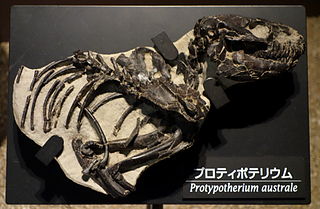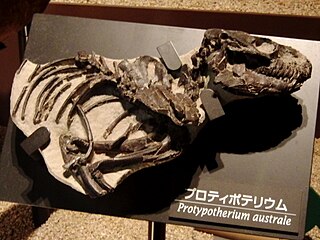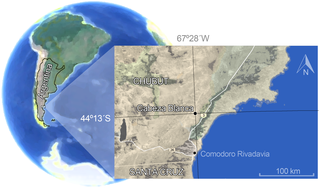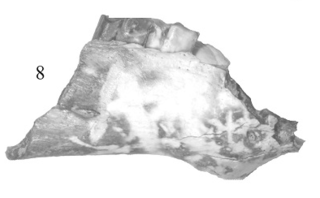
Protypotherium is an extinct genus of notoungulate mammals native to South America during the Oligocene and Miocene epochs. A number of closely related animals date back further, to the Eocene. Fossils of Protypotherium have been found in the Deseadan Fray Bentos Formation of Uruguay, Muyu Huasi and Nazareno Formations of Bolivia, Cura-Mallín and Río Frías Formations of Chile, and Santa Cruz, Salicas, Ituzaingó, Aisol, Cerro Azul, Cerro Bandera, Cerro Boleadoras, Chichinales, Sarmiento and Collón Curá Formations of Argentina.

Mesotheriidae is an extinct family of notoungulate mammals known from the Oligocene through the Pleistocene of South America. Mesotheriids were small to medium-sized herbivorous mammals adapted for digging.
The Deseadan age is a period of geologic time within the Oligocene epoch of the Paleogene to the Early Miocene epoch of the Neogene, used more specifically within the SALMA classification of South America. It follows the Tinguirirican and precedes the Colhuehuapian age.

The Malargüe Group is a group of geologic formations of the Neuquén Basin of the Mendoza, Neuquén, Río Negro and La Pampa Provinces in northern Patagonia, Argentina. The formations of the Malargüe Group range in age between the middle Campanian to Deseadan, an Oligocene age of the SALMA classification, straddling the Cretaceous–Paleogene boundary, about 79 million to 30 million years in age. The group overlies the older Neuquén Group, separated by an unconformity dated to 79 Ma. The rocks of the Malargüe Group comprise both marine and continental deposits which are over 400 m (1312 ft) thick in total.

Prohegetotherium is an extinct genus of hegetotheriid notoungulates from the Late Oligocene to Early Miocene of the Agua de la Piedra, Mariño & Sarmiento Formations of Argentina, the Petaca and Salla Formations of Bolivia, and Fray Bentos Formation of Uruguay.
The Agua de la Piedra Formation is a Late Oligocene geologic formation of the Malargüe Group that crops out in the southernmost Precordillera and northernmost Neuquén Basin in southern Mendoza Province, Argentina.
Propachyrucos is an extinct genus of hegetotheriid notoungulate. It lived from the Late Oligocene to the Early Miocene, in what is today South America.
Antofagastia is an extinct genus of Notoungulate, belonging to the family Interatheriidae. It lived during the Late Eocene in what is today South America.

Interatheriinae is an extinct subfamily of interatheriids that consisted of notoungulates dating from the Early Eocene to the Early Pliocene. The subfamily includes the genera Archaeophylus, Argyrohyrax, Boleatherium, Brucemacfaddenia, Caenophilus, Choichephilum, Cochilius, Eopachyrucos, Federicoanaya, Interatherium, Juchuysillu, Miocochilius, Neoicochilus, Patriarchus, Proargyrohyrax, Progaleopithecus, Protypotherium, and Santiagorothia. They were small to medium sized interatheres, and when compared to the other subfamily, Notopithecinae, interatheriines are found to occupy an advanced, derived position in the family.
Argyrohyrax is an extinct genus of interatheriid notoungulate that lived during the Late Oligocene, of what is now Argentina and Bolivia.
Santiagorothia is an extinct genus of interatheriid notoungulate. It lived during the Early Oligocene, and its fossils were discovered in Argentina and Chile.

Cochilius is an extinct genus of interatheriid notoungulate that lived between the Late Oligocene and the lower Miocene in what is now Argentina.

Notopithecus is an extinct genus of Notoungulate, belonging to the suborder Typotheria. It lived from the Middle to the Late Eocene and its fossilized remains were discovered in South America.

The Sarmiento Formation, in older literature described as the Casamayor Formation, is a geological formation in Chubut Province, Argentina, in central Patagonia, which spans around 30 million years from the mid-Eocene to the early Miocene. It predominantly consists of pyroclastic deposits, which were deposited in a semi-arid environment. It is divided up into a number of members. The diverse fauna of the Sarmiento Formation, including a variety of birds, crocodilians, turtles and snakes, also includes many mammals such as South American native ungulates as well as armadillos, and caviomorph rodents.
Boleatherium is an extinct genus of interatheriid notoungulate that lived from the Early to Middle Miocene of what is now Argentina. Fossils of this genus have been found in the Cerro Boleadoras Formation, the formation which this genus was named after.

Eopachyrucos is an extinct genus of interatheriid notoungulates that lived from the Middle Eocene to the Late Oligocene of Argentina and Uruguay. Fossils of this genus have been found in the Sarmiento Formation of Argentina and the Fray Bentos Formation of Uruguay.
Teushentherium is an extinct genus of notohippid notoungulate from the Oligocene of Argentina. Fossils have been found in the Sarmiento Formation of Argentina.

Proargyrohyrax is an extinct genus of interatheriine notoungulates that lived from the Early to Middle Oligocene in what is now Argentina. Fossils of this genus have been found in the Sarmiento Formation of Argentina.
Federicoanaya is an extinct genus of interatheriine notoungulates that lived during the Late Oligocene in what is now Bolivia. Fossils of this genus have been found in the Salla Formation of Bolivia.
Brucemacfaddenia is an extinct genus of interatheriine notoungulates that lived during the Late Oligocene in what is now Bolivia. Fossils of this genus have been found in the Salla Formation of Bolivia.


















